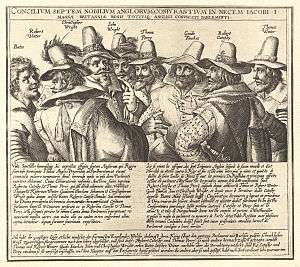Guy Fawkes

Remember, remember, the Fifth of November;
Should ever be forgot.
The gunpowder treason and plot;
I know of no reason why the gunpowder treason—Traditional rhyme
Guy or Guido Fawkes (1570-1606) was a member of a band of English Catholics who in 1605 planned to blow up the English House of Lords, thereby killing the king, James I, as well as many other significant anti-Catholic targets. Their conspiracy became known as the "Gunpowder Plot".
Contrary to popular belief, Fawkes was not the leader of the Gunpowder Plot; the true leader was a charismatic zealot named Robert Catesby. The group of thirteen conspirators met in secret at an inn several times through the year 1605. In October, the plot was finalised, but an anonymous letter (generally believed to have been written by Francis Tresham, the thirteenth member of the conspiracy) was sent to Lord Monteagle, telling him of the plot details. The letter was shown to the king on November 1. Four days later, a search party sent by the king found Fawkes in a room under the House of Lords, ready to travel, and carrying the means to set off the barrels of gunpowder hidden under a woodpile in the room. He was arrested and interrogated, during which he claimed to be acting alone. At the order of the King he was moved to the Tower of London, where he was tortured until he broke and confessed on November 7.
Catesby and several of the other conspirators were shot and killed on November 8 when a force of 200 men beseiged a manor house in which they had taken refuge. The surviving conspirators were brought back to London, where at the end of January 1606 they and Guy Fawkes were tried, condemned and then hanged, drawn and quartered, all within a matter of days.
In subsequent years, it became a British tradition to burn an effigy of Guy Fawkes in a bonfire every November 5th, which is called (reasonably enough) Guy Fawkes Night. (The earliest such celebrations were within two years of Fawkes' arrest; Canterbury's celebration in 1607 is particularly well documented.) The tradition has continued to this very day, some four centuries later, and includes masks inspired by Fawkes. The practice was exported to the American colonies but died out there after the Revolutionary War. While there was a decline in celebrating Guy Fawkes Day by the beginning of the 19th century, Victorian England revived and revivified the practice, even expanding on it by adding fireworks to the traditional bonfires.
- Thirteen Is Unlucky - There were thirteen members of the plot.
- Western Terrorists
Comic Books
- V for Vendetta -- the titular V dresses not only in a Guy Fawkes mask but in full 16th-century British garb, to deliberately invoke anarchic spirit of the original. V eventually succeeds in blowing up the Houses of Parliament on November 5.
Film
- The 2006 film version of V for Vendetta, naturally enough, and incidentally inspiring the use of the Guy Fawkes mask as a symbol by anti-establishment groups worldwide.
Literature
- Albus Dumbledore's phoenix in Harry Potter is named Fawkes because it periodically immolates itself and is reborn from its ashes.
- In Charles Dickens' novel Martin Chuzzlewit it is said that a member of the Chuzzlewit family was "unquestionably" involved in the Gunpowder Plot, and that Fawkes himself may indeed have been a scion of the family's "remarkable stock."
Music
- Revenge Is Done by Drakkar (Italian one) takes on the plot from a different angle. Or explains the doublespeak in the original couplet, depending on how you read that one.